Kristine Hughes's Blog, page 86
October 6, 2014
LOOSE IN LONDON: KRISTINE LEAVES FOR HEATHROW

I must confess that I had a bit of struggle preparing for my journey to England. The trouble began, as it often does, with the packing - the London weather was throwing me off. I'd been watching the weather reports and the temperatures were in the 70's. No rain. Blue skies. I couldn't believe it. In fact, I refused to believe it. Or, I refused to believe that the fine weather would hold once I'd set foot on British soil. It's never been nice weather when I've been in England. Ever. There may be a fine day or two, but a veritable heat wave? It couldn't last.
So I began pulling out clothes for every kind of weather, including boots, scarves, an Eisenhower jacket with a fur collar, a trench coat, a velvet winter coat . . . . and all manner of assorted clothing in between. I felt that, like the Duke of Wellington, I should prepare for every eventuality. Wellington prepared for every battle by taking into account the possible conditions of the field in any event - fine weather, rain, mud, searing sun, thunder storms, etc. Knowing that English weather could very well include all of those conditions in a single day, I thought I should be prepared, as well. Of course, Wellington also had myriad packing cases and baggage carts at his disposal, along with a full compliment of ADC's to do his packing for him. I had only myself and a single large, red suitcase.
So in the end I took half of what I'd packed out of the equation, sorted everything into those clear plastic travel bags, rolled them up to get the air out and flatten them and threw in a few pair of shoes, hair curlers, a bottle of rum, a book, various other sundries and the two flat boxes of tour stuff I'd previously packed. I put my computer. camera, power cords, cosmetics and essential paperwork in a hand held carry on and slung a large, slouchy hobo purse over my shoulder and deemed myself ready to head to the airport for the first leg of my trip - the flight from Florida to Newark.
"Are you sure this bag isn't too heavy?" Hubby asked as he wheeled the red suitcase out to the car. "Maybe we should weigh it."
"I can't take any less than that, I'm going to England for a month, after all. I need more than just a change of underwear and a toothbrush."
"Well, okay, but don't say I didn't warn you," Hubby said, struggling to lift the suitcase and tip it into the trunk of the car.
We drove in silence for a few miles before Hubby said, "I really think we should have weighed your suitcase."
Sigh. This was beginning to grow tahrsome. "You should have come to England with me," I said, more to take Hubby's mind off my luggage than because I actually meant it.
Hubby took his eyes off the road and cut a horrified gaze in my direction. "For a month of Wellington stuff? No thanks! You go with Vicky and have fun. I'll hold down the fort."
We were silent for the rest of the trip to the airport, Hubby no doubt thinking about his close escape while I thought about Hubby's forgetting to water my garden for an entire month whilst he held sway at the fort.
Before long, Hubby was pulling the car in front of the JetBlue departure's area. I pushed the trunk release button while he popped out and round the back to wrestle with the suitcase.
"You want me to help you in with this? It's pretty heavy."
"No. I'll be just fine," I said as I wrapped my arms around his neck and leaned in for a kiss. "Please water the garden while I'm gone."
"For the last time, plants don't need to be watered every day."
"The ones in pots do. Please."
"Okay, okay. Do you have everything you need? Plane tickets? Passport? Money?"
"Yes, I've got everything. I'll miss you," I said, giving Hubby a last kiss.
"Yeah, me too. Say hi to Artie for me."
"Will do," I told him as I raised the handle on the big, red suitcase and started off
"You sure that's not too heavy?" Hubby called after me.
I waved a final goodbye and entered the terminal, making my way to the JetBlue counter, where I handed over my passport.
The representative tapped a few keys before asking, "Are you checking any luggage today?"
"One piece," I said, grappling with Big Red in order to place it on the scale.
"It's over weight," the rep said.
"By how much?" I asked.
"Four pounds. Can you take something out?"
"And put it where?" I asked. "I mean, if I take stuff out of the suitcase and put it in my carry on instead, I'd still be four pounds over the limit, wouldn't I? It's all going on the same flight, whether it's in the hold or in the cabin, isn't it? How much extra would I have to pay in order to keep everything where it is?" I slid my JebBlue Amex card across the counter to him.
The rep looked at the card and sighed. "Well, I'm willing to put the bag through as it is, but they might catch the overage in the baggage area."
I smiled at him. "Thank you."
"Right," he said, handing over my boarding pass. "You've got priority for the security screening and extra leg room seating. Enjoy your flight."
"Thanks again," I told him before heading to my gate.
So much for overweight luggage. All of Hubby's worry had been for nothing after all. This trip was going to be a lark.
PART TWO COMING SOON!
Published on October 06, 2014 00:00
October 3, 2014
TRAVELS WITH VICTORIA: VISITING JOSEPHINE BONAPARTE'S MALMAISON
August 20, 2014.
 I recently had a free day in Paris and talked my husband Ed into accompanying me to visit the Chateau de Malmaison in the town of Rueil-Malmaison, about seven miles outside the city.
I recently had a free day in Paris and talked my husband Ed into accompanying me to visit the Chateau de Malmaison in the town of Rueil-Malmaison, about seven miles outside the city.
 Josephine's portraits in the Emperor's Apartment
Josephine's portraits in the Emperor's Apartment
 Josephine in 1806, by Henri-Francois RiesenerJosephine purchased the chateau (built in the 17thCentury) in 1799 and used it as her retreat from the rigors of life as the eventual Empress of France in the Tuileries Palace. In this charming country house, she could cultivate her roses and enjoy peaceful solitude or host intimate soirees and picnics with chosen guests.
Josephine in 1806, by Henri-Francois RiesenerJosephine purchased the chateau (built in the 17thCentury) in 1799 and used it as her retreat from the rigors of life as the eventual Empress of France in the Tuileries Palace. In this charming country house, she could cultivate her roses and enjoy peaceful solitude or host intimate soirees and picnics with chosen guests.

 The Entrance Hall
The Entrance Hall
Josephine was born on the Caribbean island of Martinique, June 23, 1763, named Marie-Joseph-Rose de Tascher de la Pagerie. She grew up among the sugar plantation society on the island At age seventeen, she went to Paris for an arranged marriage to Count Alexandre de Beauharnais. With him she had two children, a son, Eugene de Beauharnais (1781-1824) and a daughter, Hortense (1783-1837). Imprisoned during the Revolution, the Count was guillotined in 1794, but Josephine was released.
 The Billiard Room
The Billiard Room
When she met the young officer Napoleon Bonaparte (1769-1821), he fell madly in love with her. Until he renamed her Josephine, she was known as Rose. They married in 1796. In December 1804, in the Cathedral of Notre Dame, Paris, Napoleon crowned himself Emperor and Josephine Empress of France, in the presence of the Court and the Pope.
 Le Salon Doré
Le Salon Doré
Unable to bear any more children, Josephine reluctantly agreed to separation and divorce. In December 1809, she moved permanently to Malmaison.
 The Music Room
The Music Room
 Josephine's Harp and Pianoforte
Josephine's Harp and Pianoforte
Napoleon married Marie Louise, daughter of Austrian Emperor Francis I, and a year later, in 1811, his only legitimate child was born. He was named Napoleon, designated the King of Rome. [This unfortunate young man, so greatly anticipated, died in his early 20’s.]
 Dining Room
Dining Room
In April, 1814, Napoleon abdicated, turning Paris over to the Allied Powers of Europe and Britain, and going into exile on Elba. In May of 1814, Josephine died at Malmaison, of pneumonia, which developed from a cold she caught while walking in her garden with the Russian Tsar Alexander, one of the victorious allies in the first defeat of Napoleon.
 La Salle du Conseil (Council Room)
La Salle du Conseil (Council Room)
 Portrait of Thomas Jefferson, in the Council Room
Portrait of Thomas Jefferson, in the Council Room
Napoleon, though not always faithful to Josephine, remained attached to her for the rest of his life, even through his divorce and re-marriage. After her death and before his final exile to St. Helena, Napoleon returned to Malmaison for a farewell visit.


 La Bibliothéque (The Library)
La Bibliothéque (The Library)
By her first husband, Josephine was the grandmother of Napoleon III, son of her daughter. She is also an ancestress of numerous European Royals.
So far, all my pictures were taken in rooms on the ground floor of the house, all with doors opening into the gardens. Upstairs were the private chambers of Napoleon and Josephine each with their own apartments, i.e. suites of rooms.

 two angles on Le Salon de l'Empereur
two angles on Le Salon de l'Empereur
 La chamber à coucher de l'Empereur
La chamber à coucher de l'Empereur
 Napoleon's shaving stand
Napoleon's shaving stand
The two personal apartments are divided by rooms containing treasures the couple accumulated.
 Ceremonial Swords
Ceremonial Swords
 A version of David's Napoleon Crossing the Great Saint-Bernard Pass
A version of David's Napoleon Crossing the Great Saint-Bernard Pass
 Josephine's gold table serviceThe suite of rooms belonging to Josephine begins with a sitting room filled with red velvet and gilt chairs with white swan armrests, unique in my experience, Not even the Prince Regent had these! I can only assume that he never heard of them.
Josephine's gold table serviceThe suite of rooms belonging to Josephine begins with a sitting room filled with red velvet and gilt chairs with white swan armrests, unique in my experience, Not even the Prince Regent had these! I can only assume that he never heard of them.


 Three Views of the Frieze Room, named for the Greco-Roman frieze, also featuring swans
Three Views of the Frieze Room, named for the Greco-Roman frieze, also featuring swans
 La chambre à coucher de l'Impératrice
La chambre à coucher de l'Impératrice
Note the Swan theme continues.
 Washstand of Mahogany and Sèvres porcelainNext to the tented bedroom is another bedroom, known as La chamber ordinaire de l'Impératrice and Le Cabinet a toilette.
Washstand of Mahogany and Sèvres porcelainNext to the tented bedroom is another bedroom, known as La chamber ordinaire de l'Impératrice and Le Cabinet a toilette.




After Josephine’s death, son Eugene lived at Malmaison; later it was sold several times before being presented as a gift to the nation of France by Daniel Iffla (known as Osiris), art enthusiast and philanthropist, whose collections can be seen in a small museum on the chateau’s grounds.
 More soon on Malmaison's gardens.
More soon on Malmaison's gardens.
If you want to visit, allow about 90 minutes each way on the Metro (to La Defense) and by bus. Malmaison is currently closed on Tuesdays.
 I recently had a free day in Paris and talked my husband Ed into accompanying me to visit the Chateau de Malmaison in the town of Rueil-Malmaison, about seven miles outside the city.
I recently had a free day in Paris and talked my husband Ed into accompanying me to visit the Chateau de Malmaison in the town of Rueil-Malmaison, about seven miles outside the city.
 Josephine's portraits in the Emperor's Apartment
Josephine's portraits in the Emperor's Apartment Josephine in 1806, by Henri-Francois RiesenerJosephine purchased the chateau (built in the 17thCentury) in 1799 and used it as her retreat from the rigors of life as the eventual Empress of France in the Tuileries Palace. In this charming country house, she could cultivate her roses and enjoy peaceful solitude or host intimate soirees and picnics with chosen guests.
Josephine in 1806, by Henri-Francois RiesenerJosephine purchased the chateau (built in the 17thCentury) in 1799 and used it as her retreat from the rigors of life as the eventual Empress of France in the Tuileries Palace. In this charming country house, she could cultivate her roses and enjoy peaceful solitude or host intimate soirees and picnics with chosen guests.

 The Entrance Hall
The Entrance HallJosephine was born on the Caribbean island of Martinique, June 23, 1763, named Marie-Joseph-Rose de Tascher de la Pagerie. She grew up among the sugar plantation society on the island At age seventeen, she went to Paris for an arranged marriage to Count Alexandre de Beauharnais. With him she had two children, a son, Eugene de Beauharnais (1781-1824) and a daughter, Hortense (1783-1837). Imprisoned during the Revolution, the Count was guillotined in 1794, but Josephine was released.
 The Billiard Room
The Billiard RoomWhen she met the young officer Napoleon Bonaparte (1769-1821), he fell madly in love with her. Until he renamed her Josephine, she was known as Rose. They married in 1796. In December 1804, in the Cathedral of Notre Dame, Paris, Napoleon crowned himself Emperor and Josephine Empress of France, in the presence of the Court and the Pope.
 Le Salon Doré
Le Salon DoréUnable to bear any more children, Josephine reluctantly agreed to separation and divorce. In December 1809, she moved permanently to Malmaison.
 The Music Room
The Music Room Josephine's Harp and Pianoforte
Josephine's Harp and PianoforteNapoleon married Marie Louise, daughter of Austrian Emperor Francis I, and a year later, in 1811, his only legitimate child was born. He was named Napoleon, designated the King of Rome. [This unfortunate young man, so greatly anticipated, died in his early 20’s.]
 Dining Room
Dining RoomIn April, 1814, Napoleon abdicated, turning Paris over to the Allied Powers of Europe and Britain, and going into exile on Elba. In May of 1814, Josephine died at Malmaison, of pneumonia, which developed from a cold she caught while walking in her garden with the Russian Tsar Alexander, one of the victorious allies in the first defeat of Napoleon.

 La Salle du Conseil (Council Room)
La Salle du Conseil (Council Room) Portrait of Thomas Jefferson, in the Council Room
Portrait of Thomas Jefferson, in the Council RoomNapoleon, though not always faithful to Josephine, remained attached to her for the rest of his life, even through his divorce and re-marriage. After her death and before his final exile to St. Helena, Napoleon returned to Malmaison for a farewell visit.


 La Bibliothéque (The Library)
La Bibliothéque (The Library)By her first husband, Josephine was the grandmother of Napoleon III, son of her daughter. She is also an ancestress of numerous European Royals.
So far, all my pictures were taken in rooms on the ground floor of the house, all with doors opening into the gardens. Upstairs were the private chambers of Napoleon and Josephine each with their own apartments, i.e. suites of rooms.

 two angles on Le Salon de l'Empereur
two angles on Le Salon de l'Empereur La chamber à coucher de l'Empereur
La chamber à coucher de l'Empereur Napoleon's shaving stand
Napoleon's shaving standThe two personal apartments are divided by rooms containing treasures the couple accumulated.
 Ceremonial Swords
Ceremonial Swords A version of David's Napoleon Crossing the Great Saint-Bernard Pass
A version of David's Napoleon Crossing the Great Saint-Bernard Pass Josephine's gold table serviceThe suite of rooms belonging to Josephine begins with a sitting room filled with red velvet and gilt chairs with white swan armrests, unique in my experience, Not even the Prince Regent had these! I can only assume that he never heard of them.
Josephine's gold table serviceThe suite of rooms belonging to Josephine begins with a sitting room filled with red velvet and gilt chairs with white swan armrests, unique in my experience, Not even the Prince Regent had these! I can only assume that he never heard of them.


 Three Views of the Frieze Room, named for the Greco-Roman frieze, also featuring swans
Three Views of the Frieze Room, named for the Greco-Roman frieze, also featuring swans  La chambre à coucher de l'Impératrice
La chambre à coucher de l'ImpératriceNote the Swan theme continues.
 Washstand of Mahogany and Sèvres porcelainNext to the tented bedroom is another bedroom, known as La chamber ordinaire de l'Impératrice and Le Cabinet a toilette.
Washstand of Mahogany and Sèvres porcelainNext to the tented bedroom is another bedroom, known as La chamber ordinaire de l'Impératrice and Le Cabinet a toilette.




After Josephine’s death, son Eugene lived at Malmaison; later it was sold several times before being presented as a gift to the nation of France by Daniel Iffla (known as Osiris), art enthusiast and philanthropist, whose collections can be seen in a small museum on the chateau’s grounds.
 More soon on Malmaison's gardens.
More soon on Malmaison's gardens.If you want to visit, allow about 90 minutes each way on the Metro (to La Defense) and by bus. Malmaison is currently closed on Tuesdays.
Published on October 03, 2014 00:30
October 1, 2014
THE WELLINGTON TOUR: DENISE'S TAKE ON APSLEY HOUSE

Victoria and I are still organizing our thoughts and photos from The Duke of Wellington Tour and will begin posting in earnest about the Tour soon, In the meantime, you can read Denise Costello's fabulous post about our private tour of Apsley House here in order to find out what she discovered behind these doors.
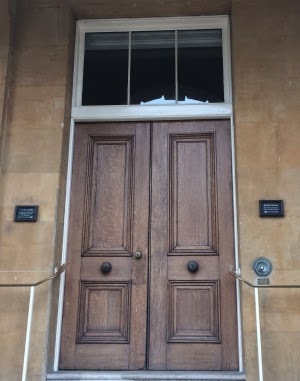
Published on October 01, 2014 00:00
September 29, 2014
THE PASSING OF THE DUCHESS OF DEVONSHIRE
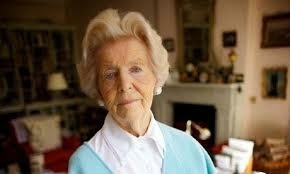
It was with great sadness that Victoria and I learned the news of the passing of Deborah Mitford, Dowager Duchess of Devonshire on September 24th. She was such an icon and was so instrumental in the survival of one of our favourite stately homes, Chatsworth House in Derbyshire.
Here we've rounded up some of the recent stories that have focused on the life, times, influence and charm of the Dowager Duchess of Devonshire. We hope that by reading these articles you, too, will remember her fondly or, should you be unfamiliar with her story, that you will learn more about the Duchess of Devonshire.
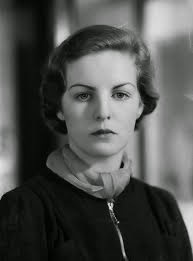
Vanity Fair remembers the Duchess of Devonshire
Vogue Magazine on the passing of the last Mitford sister
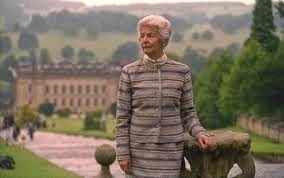
BBC News looks back on the Duchess's influence on the success of Chatsworth House
Royal tribute for the Dowager Duchess of Devonshire

A post on the Dowager Duchess of Devonshire written by Victoria that appeared on this blog in September of 2012 can be found here.
Funeral details announced - public are welcome
Published on September 29, 2014 00:00
September 26, 2014
RELIVING THE DREAM: TRAVELS WITH VICTORIA
 Place de la République, Paris My travels this summer were indeed the dream of a lifetime, over a month spent in France and England. And with two of my favorite people in the world, France with my husband Ed -- and England with blog partner Kristine. No one could ask for more, unless that both of them were along for the whole time. As I write this, I am still rather jet-lagged, days and nights mixed up. Kristine reports she had a relapse of her cold and is bed-bound for a while. Of course, one might never mention the condition of our feet -- or leg muscles, backs, and overflowing brains, so I won't.
Place de la République, Paris My travels this summer were indeed the dream of a lifetime, over a month spent in France and England. And with two of my favorite people in the world, France with my husband Ed -- and England with blog partner Kristine. No one could ask for more, unless that both of them were along for the whole time. As I write this, I am still rather jet-lagged, days and nights mixed up. Kristine reports she had a relapse of her cold and is bed-bound for a while. Of course, one might never mention the condition of our feet -- or leg muscles, backs, and overflowing brains, so I won't.
 Courtyard of Crown Plaza République So while I try to re-enter the real world after this fabulous interlude of travel (sore feet notwithstanding), I will share a few pictures and thoughts from France. Kristine and I intend to do quite a few posts on our Duke of Wellington Tour and our many other adventures in England, but for the moment, please join me near Paris.
Courtyard of Crown Plaza République So while I try to re-enter the real world after this fabulous interlude of travel (sore feet notwithstanding), I will share a few pictures and thoughts from France. Kristine and I intend to do quite a few posts on our Duke of Wellington Tour and our many other adventures in England, but for the moment, please join me near Paris.
 Malmaison Ed and I had several visits in mind to some of the lesser known museums and sites. Paris in August is full of visitors, so we wanted to see what we could find just off the beaten track. One of my personal goals was to visit the home of Josephine, who married then divorced Napoleon so that he could wed a younger woman and sire an heir. Malmaison was her escape form the rigors of the Court, where she could relax and fill her garden with the roses for which she is so famous.
Malmaison Ed and I had several visits in mind to some of the lesser known museums and sites. Paris in August is full of visitors, so we wanted to see what we could find just off the beaten track. One of my personal goals was to visit the home of Josephine, who married then divorced Napoleon so that he could wed a younger woman and sire an heir. Malmaison was her escape form the rigors of the Court, where she could relax and fill her garden with the roses for which she is so famous.
 Malmaison The house is lovely, and truly worth a visit. The gardens overflow with flowers, though I suspect Josephine would have kept them a bit better. It is said that after her death, and just before he was sent away to St. Helena in 1815, Napoleon returned to Malmaison to mourn his lost love, not to mention his empire.
Malmaison The house is lovely, and truly worth a visit. The gardens overflow with flowers, though I suspect Josephine would have kept them a bit better. It is said that after her death, and just before he was sent away to St. Helena in 1815, Napoleon returned to Malmaison to mourn his lost love, not to mention his empire.
 La Defénse On the way back from suburban Malmaison, we stopped to take a look at La Defénse, la Grand Arche, which is the western-most point of the axis of the Champs Élysées through the Arc de Triomphe. Guidebooks report that the Arche is so large that the entire Notre Dame Cathedral could fit inside it. It is certainly impressive, set in an esplanade among a huge number of sleek modern hi-rise buildings, but to me, it doesn't say anything except concrete. It has none of the beauty of the rest of Paris.
La Defénse On the way back from suburban Malmaison, we stopped to take a look at La Defénse, la Grand Arche, which is the western-most point of the axis of the Champs Élysées through the Arc de Triomphe. Guidebooks report that the Arche is so large that the entire Notre Dame Cathedral could fit inside it. It is certainly impressive, set in an esplanade among a huge number of sleek modern hi-rise buildings, but to me, it doesn't say anything except concrete. It has none of the beauty of the rest of Paris. Église du Dôme, Hôtel des Invalides On our stroll to the Musée Rodin, we passed nearby Invalides, where Napoleon is buried. We decided to let him rest in peace, rather than whisper to his tomb about the victory of the Duke of Wellington almost 200 years ago at Waterloo.
Église du Dôme, Hôtel des Invalides On our stroll to the Musée Rodin, we passed nearby Invalides, where Napoleon is buried. We decided to let him rest in peace, rather than whisper to his tomb about the victory of the Duke of Wellington almost 200 years ago at Waterloo.
 The Thinker, Musée Rodin The Musée Rodin in the Hôtel Biron is lovely, and as the weather cooperated, we spend a great deal of time in the beautiful garden where a convenient café beckoned.
The Thinker, Musée Rodin The Musée Rodin in the Hôtel Biron is lovely, and as the weather cooperated, we spend a great deal of time in the beautiful garden where a convenient café beckoned.
 the Garden from above As you can see, we had sunny weather with clouds from time to time, warm temperatures -- and so it was to be for our entire stay in France as well as almost to the first day of autumn in England.
the Garden from above As you can see, we had sunny weather with clouds from time to time, warm temperatures -- and so it was to be for our entire stay in France as well as almost to the first day of autumn in England.I will continue meandering through Paris and Normandy intermixed with our posts on England, so stay tuned for more. Adieu.
Published on September 26, 2014 00:30
September 24, 2014
LONDON - A DIFFERENT PERSPECTIVE
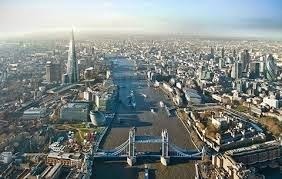
As a city, London survives in the 21st century by taking advantage of it's three rivers - the River Thames, the river of ground traffic and the constant flow of traffic in the skies. This video (46 mins) takes you behind the scenes of modern day London to see how it's all kept ticking over.
How does Heathrow airport manage half a million flights a year - using only two runways? Heathrow's split second landing and take off precision is explained in this video.
Traffic on London's streets is controlled by CCTV, the eye in the sky. Main arteries and ring roads all pour into what remain essentially 18th and 19th century roads. How is it all managed and how is congestion averted? Tolls, sensors and other cutting edge technology help to keep London traffic jam free. Oh, and should you be thinking of pulling off any crimes using London streets, think again, mate.
On the River Thames, navigation is only one aspect of keeping traffic moving - life saving, obstacle removal and port control and surveillance all combine to form a river system that would make the East India Company proud.
Published on September 24, 2014 00:00
September 18, 2014
LOOSE IN LONDON: INTERESTING BOOKS
Here are a selection of book titles, in no particular order, that interested us during our visits to various book shops. We thought we'd take photos of the titles and order them from home instead of lugging the books around the countryside with us. Live and learn!









Published on September 18, 2014 10:08
September 17, 2014
THE WELLINGTON CONNECTION: FLYING HORSES
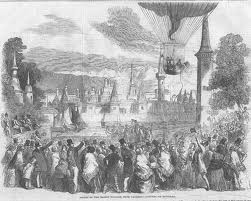
Letter from the Duke of Wellington to Lady Salisbury -
Walmer, September 18, 1850
. . . . . Thank you for your letter of the 17th . . . Gale's case is a terrible one! Carrying a horse in a balloon is the most senseless of acts! A wooden horse of the same weight, or the same weight of common ballast, would answer in every real purpose of experiment!
From The Times, September 16, 1850: Lieutenant Gale went up from Vincennes on May 11, carrying a horse in his balloon. He reached earth safely, and released the poor beast, who, though benumbed, was not injured and after a while cropped the grass. Unluckily, Gale could not speak French, and was reduced to signs to make the peasants, who crowded around, understand that they must hold the tethering ropes. His gesticulations merely alarmed them, and when, after opening the valves, he drew a big knife to cut the cords, they let go, and the balloon, with Gale clinging to the ropes, soared up anew. His body, half-eaten by dogs, was finally discovered in a field and he was buried at Bordeaux.
Published on September 17, 2014 00:00
September 14, 2014
DEATH OF WELLINGTON AT WALMER
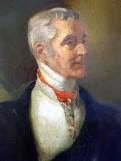
From The History of Walmer and Walmer Castle by Charles Robert Stebbing Elvin (1894)The Duke of Wellington was Lord Warden for nearly four and twenty years, and during all that time rarely missed coming to Walmer after the prorogation of Parliament, staying usually till about the middle of November; and, before leaving for Strathfieldsaye, generally held at Dover a Court of Lodemanage, to discuss and settle the affairs of the Cinque Ports' pilots.
For some years before his death, the Duke had been in failing health. Seated in the drawing-room in his favourite armchair, he would often, after dinner, take a newspaper in one hand and a candle in the other, and fall asleep while reading in this dangerous position, to the great anxiety of his friend and companion, Mr. Arbuthnot. The end came suddenly at last. The Duke was accustomed to rise early, but, on September 14th, 1852, when his valet called him as usual at six o'clock, he found the Duke particularly drowsy, and thought it best to leave him undisturbed for an hour longer. He therefore withdrew, but remained within hearing. It was fortunate he did so, for soon after he was alarmed at hearing groans from the Duke's room, and on re-entering was requested to send for Dr. Hulke of Deal, who came, prescribed some simple remedies, and, seeing nothing serious in the Duke's condition, departed. Shortly after this, however, the Duke became much worse, and messages were despatched for further help. On the return of Dr. Hulke with his son and Dr. McArthur, they found his Grace breathing laboriously, unconscious, and very restless. To assist respiration he was raised and put into his easy chair, where for a time he breathed more freely; but the end was very near, and at five and twenty minutes past three he expired. A message had meanwhile been sent to London for Dr. Williams, who only arrived in time to find the mortal remains of his illustrious patient laid out upon his little camp-bed.
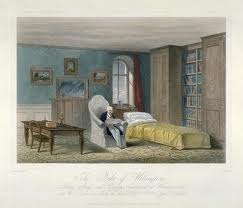
The Union Jack now drooped at half-mast high upon the castle ramparts; announcing to the world that the Iron Duke, the nation's idol was no more. The body of the departed hero remained at Walmer Castle until the eleventh of November, in the irregularly-shaped room shown in the engraving; which still retains the name of "The Duke's Room." The scene at Walmer, subsequent to the removal, cannot be better described than in the following extract from a contemporary record, which conveys a most graphic idea of all the solemn proceedings of this time :—" In the small irregularly shaped death-chamber lay the body of the Duke, inclosed in an outer coffin covered with crimson velvet, and with handles and funeral decorations richly gilt. On the lid, near the head, rested the ducal coronet, and beyond it the pall, gathered back, to give visitors a complete view. The coffin rested on a low stand, covered with black cloth, round which candelabra with huge wax lights and plumes of feathers were arranged. The walls and roof of the small apartment were, of course, hung with black cloth, the single deep-recessed window closed, and candles, reflected against silver sconces, barely relieved the gloom of the sombre display. Visitors entering at one door passed by the end of the coffin, and then out at another without interruption. The ante-chambers and corriders were also darkened, hung with black, and lighted with candles placed at intervals on the side walls.
"The first day for admission of the public was Tuesday (Nov. 9th). Through the low strong archway of the entrance the visitors passed, first, along the curved glass-covered passage, then through the dimly lighted anterooms into the chamber of death, and then along corridors and down staircases and across the garden on to the beach. All the way at a few paces distance from each other on either hand, the guard of honour of the Rifle Brigade were placed, each man with his arms reversed, and leaning in a sorrowful attitude on his musket. Along the beach, as far as the eye could reach towards Deal, a long train of visitors dressed in mourning passed and repassed throughout the day, while from greater distances conveyances arrived and took their departure in quick succession."
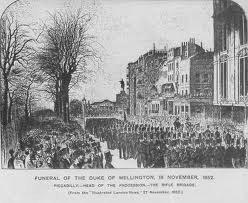
The stream of visitors continued throughout the Tuesday, and until four o'clock in the afternoon of the following day; during which time upwards of nine thousand people are said to have visited the chamber of the late Duke to witness the lying in state. But about 7 p.m. on Wednesday (Nov. 10th), the body was removed to Deal Station, en route for London, under an escort of about 150 men of the Rifle Brigade, commanded by Colonel Beckwith, and attended by mourning coaches in which were seated the Duke's eldest son and successor, Lord Arthur Hay, Captain Watts, Mr. Marsh of the Lord Chamberlain's office, and others.
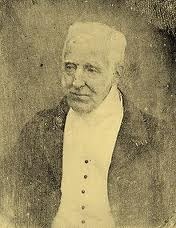 The Duke of WellingtonAs the funeral cortege prepared to leave the grounds, the solemn booming of the minute-guns resounded from the castle walls; while the wind brought back the echo from Deal and Sandown, where the like honour was paid to the memory of the deceased. Down the "sombre avenue," lighted by the lurid glare from the flambeaux with which a body of men led the way, and through the silent crowds who lined the road undeterred by chill darkness of a November night, winded the slow procession; moving with measured tread, until at length they reached Deal Station; the melancholy march of a mile and three-quarters having occupied no less than one hour and a half. There they were awaited by Mr. James Macgregor, M.P., the chairman of the South-Eastern Railway Company; and the hearse having been transferred to a truck, the journey onward to London was resumed at a quarter past nine.
The Duke of WellingtonAs the funeral cortege prepared to leave the grounds, the solemn booming of the minute-guns resounded from the castle walls; while the wind brought back the echo from Deal and Sandown, where the like honour was paid to the memory of the deceased. Down the "sombre avenue," lighted by the lurid glare from the flambeaux with which a body of men led the way, and through the silent crowds who lined the road undeterred by chill darkness of a November night, winded the slow procession; moving with measured tread, until at length they reached Deal Station; the melancholy march of a mile and three-quarters having occupied no less than one hour and a half. There they were awaited by Mr. James Macgregor, M.P., the chairman of the South-Eastern Railway Company; and the hearse having been transferred to a truck, the journey onward to London was resumed at a quarter past nine.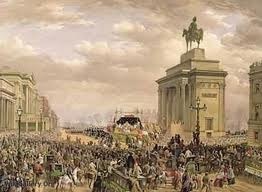 "Funeral of the Duke of Wellington the funeral car passing the archway at Apsley House"
"Funeral of the Duke of Wellington the funeral car passing the archway at Apsley House" On arriving at the Bricklayers' Arms station, the hearse with the coffin was removed to Chelsea Hospital, under an escort of the 1st Life Guards; and there the remains of the Duke continued to lie in state till removed for the Grand State Funeral which took place on the following Thursday, November 18th.
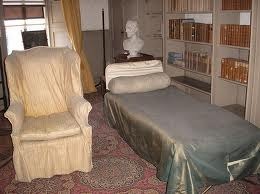
In 1861, shortly after the appointment of Lord Palmerston (as Lord of the Cinque Ports), several articles were removed from (the Duke of Wellington's room at Walmer) to Apsley House, with the consent of Lord Dalhousie's executors, in consequence of a threatened sale by auction; but these have all been recently restored, through the generosity of the present Duke of Wellington, as related further on; and "The Duke's Room" is once again as it used to be, even to the yellow moreen curtains and the orignal bedding and chair-cover. The bookshelves have, however, been wisely covered with glass doors, and so converted into a cabinet, in which many articles of interest are kept under lock and key; including the Duke's set of his own printed despatches, in twelve vols., the first volume of which has been despoiled of its title-page by some thief, or thievish collector, for the sake no doubt of the autograph. This cabinet also contains, among other things, two pairs of "Wellington" boots, and a volume of Statutes relating to the Cinque Ports, of the date of 1726. The latter was presented to the Duke of Wellington by Lord Mahon, and contains the autograph of each. One pair of the "Wellingtons," described in the schedule of heirlooms as a pair of "Field Marshall's 'Wellington' boots," are believed to be the same that were worn by the Duke at the Battle of Waterloo. The famous camp-bedstead has now a green velvet coverlet, presented by the Countess of Derby in 1893.
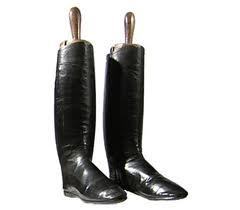
The engravings in this room include portraits of Mrs. Siddons, Mr. Burke, and Lord Onslow, as well as the Duke's print of the Chelsea pensioners reading the Gazette announcing the victory at Waterloo; and in the adjoining dressing-room, is a curious piece of work, made by the Duke's house carpenter and shown at the Exhibition in 1851, being the representation of Strathfieldsaye House, in the form of a picture, composed it is said of 3,500 pieces of wood. The Duke of Wellington thought so much of this picture that it used to hang during his lifetime in the dining-room.
Published on September 14, 2014 00:57
September 12, 2014
END OF THE BRITISH BATTLE FOR MARYLAND, 1814
Victoria here. Our last post on the War of 1812 had the British withdrawing from the area after burning Washington City and capturing the town of Alexandria, VA, without firing a shot. Under the leadership of Naval Vice Admiral Alexander Cochrane and Army General Robert Ross, the British forces prepared to take the city of Baltimore, Maryland, a more formidable prize than the half-built capital had been.
 Fort McHenry, Baltimore, MD
Fort McHenry, Baltimore, MD
In the ultimate settlement of the War of 1812, neither side achieved its aims. However, the independence of Canada from the U.S. was assured. The War of 1812 was almost forgotten (except by Canadians) until this bicentennial, with one important exception. The words to the United States National Anthem, The Star-Spangled Banner, were written as the battle raged. I wonder how many U.S. citizens know it was NOT written about the Revolutionary War.
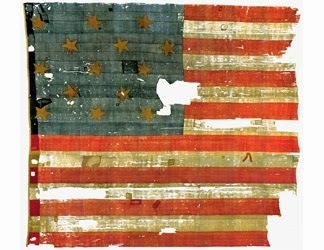 The historic flag that flew over Ft. McHenry, now on view at the Smithsonian Institution's Museum of American History, Washington D.C.
The historic flag that flew over Ft. McHenry, now on view at the Smithsonian Institution's Museum of American History, Washington D.C.
I visited Ft. McHenry in February 2014, all fixed up for the bicentennial of its finest hour. The website is here.
 Jerry, Pat and Ed at Ft. McHenry
Jerry, Pat and Ed at Ft. McHenry
It was a sunny cool day, perfectly appropriate for a visit. The Visitor Center has a short film telling the story of the 1814 battle and some excellent displays of relics of the battle.
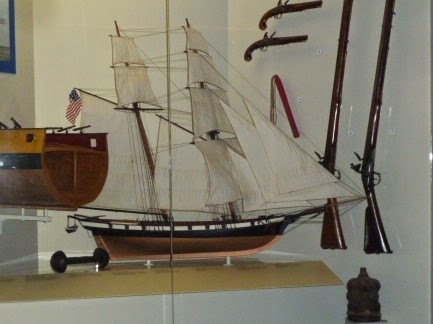 Model of the topsail schooner Chasseur
Model of the topsail schooner Chasseur
The Chasseur captured or sank 18 British ships and was known as "The Pride of Baltimore."
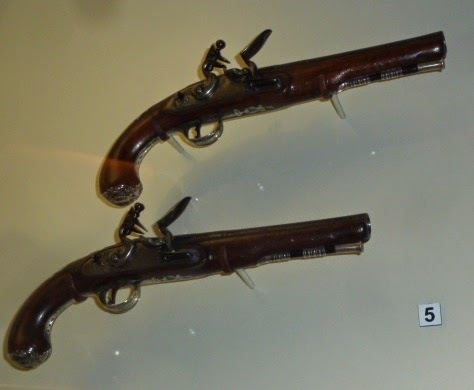 Pair of flintlock pistols
Pair of flintlock pistols
The pistols were made in London about 1800 and engraved with the motto "Steady."
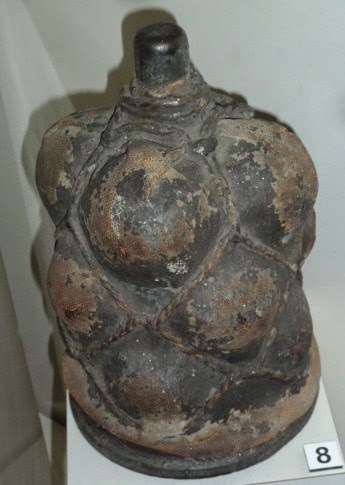 Grapeshot
Grapeshot
Made in Baltimore, about 1813; shot from a cannon, the 12-inch iron balls would scatter over a wide area and devastate a ship's rigging or seamen at close range.
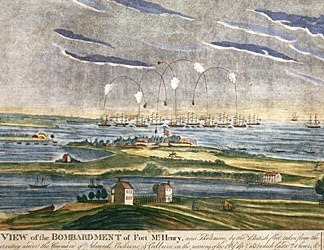 The Bombardment of Ft. McHenry by British warships
The Bombardment of Ft. McHenry by British warships
On September 13, 1814, British warships began the bombardment of Fort McHenry at 6 a.m. The British could not pass Fort McHenry because many had been sunk in the channel to prevent the enemy passage, as well as the attackers needing to sail close to the American cannons at the Fort. Eventually, after 25 hours of rather inaccurate shooting from both sides, the British ran low on ammunition and withdrew. The British ships received mostly minor damages, one person injured; the fort had four killed, 24 wounded, and damage to several of the buildings.
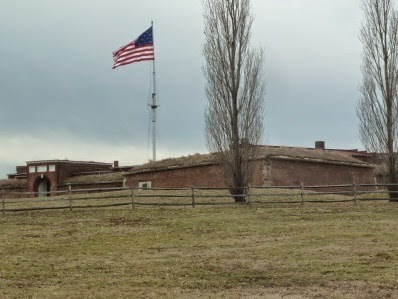 Walking up to the fort from the Visitor Center
Walking up to the fort from the Visitor Center
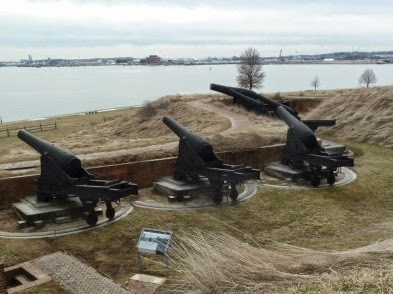 The cannons aimed at the harbor
The cannons aimed at the harbor
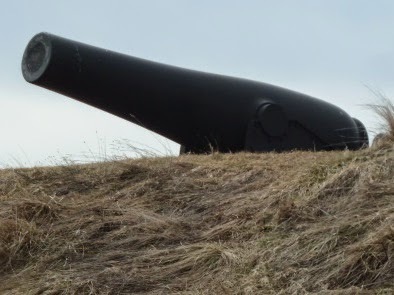 Up close and personal
Up close and personal
The day before the naval bombardment, General Robert Ross, who had led the attacks on and burning of Washington, led a group of British soldiers to what became the Battle of North Point. He was severely wounded by American sharpshooters and died as he was being returned to the fleet. After his body was placed in a barrel of Jamaican rum, it was taken to Halifax, Nova Scotia, where he is buried.
 Fort McHenry
Fort McHenry

Buildings within the fort have been restored and are well maintained; displays in many of them tell the story of Fort McHenry during the War of 1812 and the Civil War.
 Officer's Quarters
Officer's Quarters
 Costumed Guides Explain life in the fort in 1814
Costumed Guides Explain life in the fort in 1814
Getting back to the U.S. National Anthem, the lawyer and poet Francis Scott Key watched the British attack on Ft. McHenry from aboard HMS Tonnant where he had been sent to negotiate the exchange of prisoners between the British and American forces. He watched the battle from the decks, and in the morning, saw the stars and stripes flag still flying over the fort. He reported to the prisoners below deck that the battle had been won by the Americans.
 Statue of Francis Scott Key at Ft. McHenry
Statue of Francis Scott Key at Ft. McHenry
As Key returned to Baltimore, he wrote the poem "Defence of Fort M'Henry," and planned to set it to the tune of a popular song by British composer John Stafford Smith, "To Anacreon in Heaven." The poem was published on September 20, 1814, in The Patriot.
 Francis Scott Key, ca. 1816by Joseph Wood, artist (177801832)Walters Art Museum, Baltimore, MD
Francis Scott Key, ca. 1816by Joseph Wood, artist (177801832)Walters Art Museum, Baltimore, MD
We know the song today as "The Star Spangled Banner," to which we wish a Happy 200th birthday. The legislation naming it the official national anthem was adopted by Congress in 1931 and signed by President Herbert Hoover.
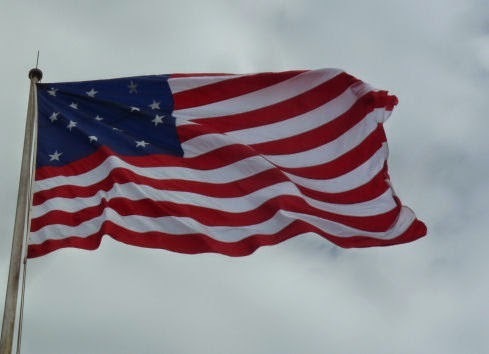 The U.S. Flag of 1814 flies over Fort McHenry.
The U.S. Flag of 1814 flies over Fort McHenry.
Oh say, can you see by the dawn's early light,
What so proudly we hailed at the twilight's last gleaming,
Whose broad stripes and bright stars through the perilous fight,
O'er the ramparts we watched, were so gallantly streaming?
And the rockets' red glare, the bombs bursting in air,
Gave proof through the night that our flag was still there;
Oh say does that star-spangled banner yet wave,
O'er the land of the free and the home of the brave?
There are several additional verses, not often sung.

.
 Fort McHenry, Baltimore, MD
Fort McHenry, Baltimore, MDIn the ultimate settlement of the War of 1812, neither side achieved its aims. However, the independence of Canada from the U.S. was assured. The War of 1812 was almost forgotten (except by Canadians) until this bicentennial, with one important exception. The words to the United States National Anthem, The Star-Spangled Banner, were written as the battle raged. I wonder how many U.S. citizens know it was NOT written about the Revolutionary War.
 The historic flag that flew over Ft. McHenry, now on view at the Smithsonian Institution's Museum of American History, Washington D.C.
The historic flag that flew over Ft. McHenry, now on view at the Smithsonian Institution's Museum of American History, Washington D.C.I visited Ft. McHenry in February 2014, all fixed up for the bicentennial of its finest hour. The website is here.
 Jerry, Pat and Ed at Ft. McHenry
Jerry, Pat and Ed at Ft. McHenryIt was a sunny cool day, perfectly appropriate for a visit. The Visitor Center has a short film telling the story of the 1814 battle and some excellent displays of relics of the battle.
 Model of the topsail schooner Chasseur
Model of the topsail schooner ChasseurThe Chasseur captured or sank 18 British ships and was known as "The Pride of Baltimore."
 Pair of flintlock pistols
Pair of flintlock pistolsThe pistols were made in London about 1800 and engraved with the motto "Steady."
 Grapeshot
GrapeshotMade in Baltimore, about 1813; shot from a cannon, the 12-inch iron balls would scatter over a wide area and devastate a ship's rigging or seamen at close range.
 The Bombardment of Ft. McHenry by British warships
The Bombardment of Ft. McHenry by British warshipsOn September 13, 1814, British warships began the bombardment of Fort McHenry at 6 a.m. The British could not pass Fort McHenry because many had been sunk in the channel to prevent the enemy passage, as well as the attackers needing to sail close to the American cannons at the Fort. Eventually, after 25 hours of rather inaccurate shooting from both sides, the British ran low on ammunition and withdrew. The British ships received mostly minor damages, one person injured; the fort had four killed, 24 wounded, and damage to several of the buildings.
 Walking up to the fort from the Visitor Center
Walking up to the fort from the Visitor Center The cannons aimed at the harbor
The cannons aimed at the harbor Up close and personal
Up close and personalThe day before the naval bombardment, General Robert Ross, who had led the attacks on and burning of Washington, led a group of British soldiers to what became the Battle of North Point. He was severely wounded by American sharpshooters and died as he was being returned to the fleet. After his body was placed in a barrel of Jamaican rum, it was taken to Halifax, Nova Scotia, where he is buried.
 Fort McHenry
Fort McHenry
Buildings within the fort have been restored and are well maintained; displays in many of them tell the story of Fort McHenry during the War of 1812 and the Civil War.
 Officer's Quarters
Officer's Quarters Costumed Guides Explain life in the fort in 1814
Costumed Guides Explain life in the fort in 1814Getting back to the U.S. National Anthem, the lawyer and poet Francis Scott Key watched the British attack on Ft. McHenry from aboard HMS Tonnant where he had been sent to negotiate the exchange of prisoners between the British and American forces. He watched the battle from the decks, and in the morning, saw the stars and stripes flag still flying over the fort. He reported to the prisoners below deck that the battle had been won by the Americans.
 Statue of Francis Scott Key at Ft. McHenry
Statue of Francis Scott Key at Ft. McHenryAs Key returned to Baltimore, he wrote the poem "Defence of Fort M'Henry," and planned to set it to the tune of a popular song by British composer John Stafford Smith, "To Anacreon in Heaven." The poem was published on September 20, 1814, in The Patriot.
 Francis Scott Key, ca. 1816by Joseph Wood, artist (177801832)Walters Art Museum, Baltimore, MD
Francis Scott Key, ca. 1816by Joseph Wood, artist (177801832)Walters Art Museum, Baltimore, MDWe know the song today as "The Star Spangled Banner," to which we wish a Happy 200th birthday. The legislation naming it the official national anthem was adopted by Congress in 1931 and signed by President Herbert Hoover.
 The U.S. Flag of 1814 flies over Fort McHenry.
The U.S. Flag of 1814 flies over Fort McHenry.Oh say, can you see by the dawn's early light,
What so proudly we hailed at the twilight's last gleaming,
Whose broad stripes and bright stars through the perilous fight,
O'er the ramparts we watched, were so gallantly streaming?
And the rockets' red glare, the bombs bursting in air,
Gave proof through the night that our flag was still there;
Oh say does that star-spangled banner yet wave,
O'er the land of the free and the home of the brave?
There are several additional verses, not often sung.

.
Published on September 12, 2014 00:00
Kristine Hughes's Blog
- Kristine Hughes's profile
- 6 followers
Kristine Hughes isn't a Goodreads Author
(yet),
but they
do have a blog,
so here are some recent posts imported from
their feed.



